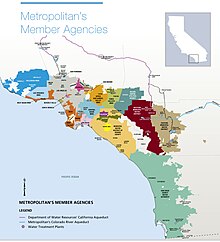Metropolitan Water District of Southern California
In the early 20th century, Southern California cities were faced with a growing population and shrinking local groundwater supplies.
Southland residents voted for a major bond in the depths of the Great Depression to fund the construction effort through the desert to deliver essential water supplies and generate badly needed jobs.
[citation needed] The post-World War II boom and 1950s dry spells prompted a huge expansion of the Metropolitan service area as new cities began seeking additional reliable water supplies.
In the early years, revenue from water sales was too low, so Metropolitan also collected taxes that ranged from 0.25 to 0.50 percent of assessed value.
In 1952, Metropolitan began a 200 million dollar program to bring the Colorado River Aqueduct to its full capacity of 1,212,000 acre-feet (1.495×109 m3) annually.
[2] In 2019 the Metropolitan Water District played a crucial role in the development of the Colorado River Drought Contingency Plan (DCP).
Once in the south coastal plain, deliveries are split between the SWP's West Branch, storing water in Castaic Lake for delivery to the west side of the Los Angeles metropolitan area, and the East Branch, which delivers water to the Inland Empire and the south and east parts of the Los Angeles Basin.
These reservoirs were built specifically to preserve water during times of drought, and are in place for emergencies uses such as earthquake, floods or other events.
This capacity is over twice as large as that of Castaic Lake, the next largest reservoir in Southern California maintained by the state Department of Water Resources.
[16] Metropolitan employs over 2,100 people to maintain and do research at these facilities,[citation needed] including scientists specializing in chemistry, microbiology, and limnology (the study of lakes and rivers).
Sodium hydroxide is added as a corrosion control measure to adjust the pH level and protect pipes and plumbing fixtures.
[citation needed] Metropolitan Water District has various EPA Environmental Protection Agency approved methods used to for the detection of bacteria, viruses, protozoan parasites, chemical contaminants and toxins.
In partnership with the Sanitation Districts of Los Angeles County and the Metropolitan Water District, The Regional Recycled Water Program will introduce purified and treated wastewater that will replenish groundwater basins across Los Angeles and Orange Counties that aims to potentially accommodate direct potable reuse demands in the near future.
[18] The program includes 60 miles (97 km) of new pipelines to convey the treated water across four regional groundwater basins, an industrial facility, and two MWD treatment plants.
[19] The full scale treatment facility would serve 500,000 homes daily and deliver a purified source of water to the four regional groundwater basins: Central, West Coast, Main San Gabriel, and Orange County.



